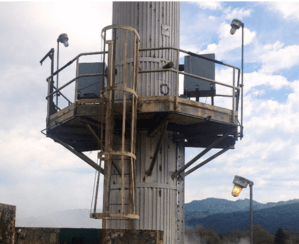Power Plant Background
Like many other coal-burning power plants still in operation, this Louisiana electric generating power plant consisting of three electric generating units (EGUs) – two pulverized coal boilers and one gas-fired boiler converted from coal – was heavily modified to reduce air emissions. With the implementation of the Mercury and Air Toxins Standard (MATS) for electric utilities, as well as a facility consent decree requiring nearly half of sulfur dioxide emissions (SO2) to be curtailed over the span of four years, the power plant was in need of a more powerful data acquisition system (DAS) to monitor its emissions.
What are the Mercury and Air Toxins Standards (MATS) for Electric Utilities?
In December 2011, the U.S. Environmental Protection Agency (EPA) finalized the Mercury and Air Toxins Standards (MATS) rule limiting the allowable amount of mercury (Hg) and other pollutants from coal and coal-fired power plants under the Clean Air Act. Under the MATS rule, all coal and oil-fired power plants with a capacity of 25 megawatts or greater are subject to the standards. The MATS rule continues to evolve and undergo various corrections and updates.
Plant Data Collection and Reporting Challenges
The power plant’s internal commitment to reducing facility emissions on top of the need to be compliant with MATS regulations posed a number of issues leading to the need for a DAS:
- Need to monitor data from both Hg and Particulate Matter (PM) Continuous Emissions Monitoring (CEM) Systems
- A converted boiler now under different regulations
- A need to import vendor gas files automatically
Electric Utility Challenge #1: Need to Monitor Data from both Hg and Particulate Matter (PM) Continuous Emissions Monitoring (CEM) Systems
MATS regulations require coal-fired units to monitor emissions of Hg and particulate matter (PM). The power plant opted to use an Hg continuous emissions monitoring system (CEMS) as well as a PM CEMS. Since the plant now had two different CEMS that analyzed different air pollutants, it needed a DAS capable of calculating separate compliance averages and limits.
Electric Utility Challenge #2: Converted Boiler Now Under Different Regulations
Once converted from coal-burning to natural gas burning, the boiler became subject to 40 CFR Part 75 regulations under Appendix D. Appendix D of the Part 75 regulations provides procedures for optional SO2 emissions monitoring estimation for oil or gas-fired units using a fuel flowmeter. Not only did the power plant need to analyze data from the Hg and PM CEMS, but also needed to calculate and compile data within Part 75 regulations from the recently converted natural gas boiler.
Electric Utility Challenge #3: Need to Import Vendor Gas Files Automatically
One of the main frustrations of the plant’s environmental engineer was that he had to manually import calibration gas cylinder vendor files into the plant’s system – a mundane and time-consuming task. The power plant needed a way to efficiently import vendor calibration gas files into the database.
Why switch to a StackVision DAS for MATS Monitoring?
ESC Spectrum’s StackVision is leading-edge data acquisition software that offers insights into emissions and compliance that other software solutions simply cannot. StackVision is the most widely used DAS software across the U.S. with more than 3,100 air emission sources in the petrochemical, refining, electric power generation, steel, and pulp and paper industries relying on it for monitoring and reporting. StackVision:
- Meets the monitoring and reporting requirements of the U.S. Environmental Protection Agency and state regulators.
- Is specifically designed to meet the needs of air continuous monitoring compliance.
- Is user-driven and has an innovative design that keeps you on top of your compliance status and trends with a real-time set of tools and displays.
- Is in constant development to stay up-to-date with the ever-changing regulatory realm.
How Did StackVision Help the Power Plant Comply with MATS Regulations?
The coal-fired plant was in desperate need of a powerful data acquisition system to meet its emissions reduction goals and compliance needs. Since implementing StackVision, the power plant has seen many improvements, including:
- Enhanced monitoring and reporting capabilities
- Access to user-customizable dashboards for efficient data reviews
- Faster data imports and increased storage
StackVision Benefit #1: Enhanced Monitoring and Reporting Capabilities
The StackVision implementation allowed the power plant to request a custom report to visualize data from Part 60, Part 75, and Part 63 certification tests across the three EGUs. StackVision’s QA Test Deadlines feature allows users to see current RATA, Linearity and Fuel Flow test results all in one place. StackVision tracks test due dates and alerts users of time in between tests as well as any applicable grace periods.
StackVison Benefit #2: Access to User Customizable Dashboards
StackVision’s user-customizable dashboards make it incredibly easy for plants to visualize emissions data from different sources across the facility. StackVision’s dashboards allowed the power plant to view custom data averages from each of its three EGUs; the plant is now able to view 3-hour and 30-day rolling averages on one of their dashboards, as well as plant-wide averages for the two coal-burning EGUs on another dashboard.
StackVision Benefit #3: Faster Data Imports and Increased Storage
StackVision’s many importable templates make it easy to input and store vendor files, such as Protocol Gas Verification Program (PGVP) certificates and calibration gas cylinder data. StackVision users can easily upload cylinder data from many vendors by scanning cylinders with a QR code scanner. StackVision’s interface recognizes and alerts the user of duplicates, maximizing the organization of files.
Successful Power Plant MATS Compliance
Thanks to StackVision, this Louisiana coal-fired electric generating power plant was able to comply with MATS regulations as well as take steps toward their goal of curbing SO2 emissions.
How Can We Help Your Refinery Comply with Emissions Regulations?
We are a full solution provider for air emissions compliance: from building CEMS shelters and performing maintenance on them, to developing Data Acquisition Systems and other compliance software, to testing, repairs, spare parts…and all the DAS and CEMS services to support those activities. Please Contact Us to see how we can help you






